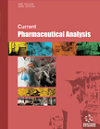- Home
- A-Z Publications
- Current Pharmaceutical Analysis
- Previous Issues
- Volume 17, Issue 3, 2021
Current Pharmaceutical Analysis - Volume 17, Issue 3, 2021
Volume 17, Issue 3, 2021
-
-
Analysis of Nonsteroidal Anti-inflammatory Drugs by using Microfluidic Techniques: A Review
More LessAuthors: Chiara Fanali, Giovanni D’Orazio, Alessandra Gentili and Salvatore FanaliIn this review paper, miniaturized techniques, including both electromigration and liquid chromatographic techniques, have been discussed considering their main features in the analytical field for the separation and analysis of Nonsteroidal Anti-inflammatory Drugs (NSAIDs). In Capillary Electrophoresis (CE) and nano-liquid chromatography (nano-LC), separation is performed in capillaries with Internal Diameter (I.D.) lowe Read More
-
-
-
Hydrophilic Interaction Liquid Chromatography (HILIC): Latest Applications in the Pharmaceutical Researches
More LessAuthors: Cem Erkmen, Weldejeworgıs H. Gebrehiwot and Bengi UsluBackground: Significant advances have been occurred in analytical research since the 1970s by Liquid Chromatography (LC) as the separation method. Reverse Phase Liquid Chromatography (RPLC) method, using hydrophobic stationary phases and polar mobile phases, is the most commonly used chromatographic method. However, it is difficult to analyze some polar compounds with this method. Another separatio Read More
-
-
-
Albumin-based Nanoparticles as Promising Drug Delivery Systems for Cancer Treatment
More LessAuthors: Ozge Esim and Canan HascicekAlbumin is an ideal material for the production of drug carrier nanoparticular systems since it is a versatile and functional protein that has been proven to be biodegradable and biocompatible, non-toxic, and immunogenic. Albumin nanoparticles are of great interest as they have the high binding capacity to many drugs with different physicochemical and structural properties and are well tolerated without any side effects. I Read More
-
-
-
An Overview of Excipients Classification and Their Use in Pharmaceuticals
More LessAuthors: Cansel K. Ozkan, Ozgur Esim, Ayhan Savaser and Yalcin OzkanThe content and the application of pharmaceutical dosage forms must meet several basic requirements to ensure and maintain efficiency, safety and quality. A large number of active substances have a limited ability to direct administration. Excipients are generally used to overcome the limitation of direct administration of these active substances. However, the function, behavior and composition of the excipients need to Read More
-
-
-
An Overview: The Evaluation of Formation Mechanisms, Preparation Techniques and Chemical and Analytical Characterization Methods of the In Situ Forming Implants
More LessAuthors: Muge Kilicarslan and Ayse N. BukeOne of the major developments of the last decade is the preparation of in situ implant formulations. Injectable, biocompatible and/or biodegradable polymer-based in situ implants are classified differently due to implant formation based on in vivo solid depot or formation mechanisms inducing liquid form, gel or solid depot. In this review, published studies to date regarding in situ forming implant systems were compiled and thei Read More
-
-
-
Voltammetric Methods Used in the Determination of Nucleoside Reverse Transcriptase Inhibitors
More LessAuthors: Fatma Ağın and Ínci S. DoğanBackground: The Human Immunodeficiency Virus (HIV) has now been established as the causative agent of the Acquired Immunodeficiency Syndrome (AIDS) and exactly 25 antiretroviral drugs have been formally approved for clinical use in the treatment of AIDS. The life quality and duration of HIV-positive patients have increased with the usage of antiretroviral drugs in the treatment of AIDS. Nucleoside Reverse Tran Read More
-
-
-
Nano-sized Metal and Metal Oxide Modified Electrodes for Pharmaceuticals Analysis
More LessAuthors: Burcu D. Topal, Ceren Elif Sener, Basak Kaya and Sibel Aysıl OzkanThe electrochemical analysis offers a number of important advantages such as providing information on pharmaceuticals analysis and their in vivo redox processes and pharmacological activity. The interest in developing electrochemical sensing devices for use in clinical assays is growing rapidly. Metallic nanoparticles can be synthesized and modified with various chemical functional groups, which allow them to be conjuga Read More
-
-
-
Challenges, Progress and Promises of Impurities Annotation for LCMSIT- TOF
More LessAuthors: Saniye Özcan, Serkan Levent and Nafiz Öncü CanAnalysis of pharmaceutical products, as well as their active and inactive ingredients, and identification and characterization of potential impurities originating from raw materials and manufacturing processes is of importance in the field, especially for further assessment of potential positive or negative effects on the human body. In addition to expected therapeutic effects, unfortunately, some unwanted or adverse effects were Read More
-
-
-
A Label-free Electrochemical Immunosensor for Highly Sensitive Detection of TNF α, Based on Star Polymer-modified disposable ITO Electrode
More LessAuthors: Elif B. Aydin, Muhammet Aydin and Mustafa Kemal SezgintürkBackground: Biomarkers are very important disease-related biomolecules which should be analyzed sensitive and selective in related physiological fluids or tissues. Tumor necrosis factor-α is a type of cytokine which plays vitlly important roles in different methabolic pathways such as cell death, survival, differentiation, proliferation and migration, and infectious and inflammatory diseases including rheumatoid arthritis, diabetes. O Read More
-
Volumes & issues
-
Volume 20 (2024)
-
Volume 19 (2023)
-
Volume 18 (2022)
-
Volume 17 (2021)
-
Volume 16 (2020)
-
Volume 15 (2019)
-
Volume 14 (2018)
-
Volume 13 (2017)
-
Volume 12 (2016)
-
Volume 11 (2015)
-
Volume 10 (2014)
-
Volume 9 (2013)
-
Volume 8 (2012)
-
Volume 7 (2011)
-
Volume 6 (2010)
-
Volume 5 (2009)
-
Volume 4 (2008)
-
Volume 3 (2007)
-
Volume 2 (2006)
-
Volume 1 (2005)
Most Read This Month
Article
content/journals/cpa
Journal
10
5
false
en


